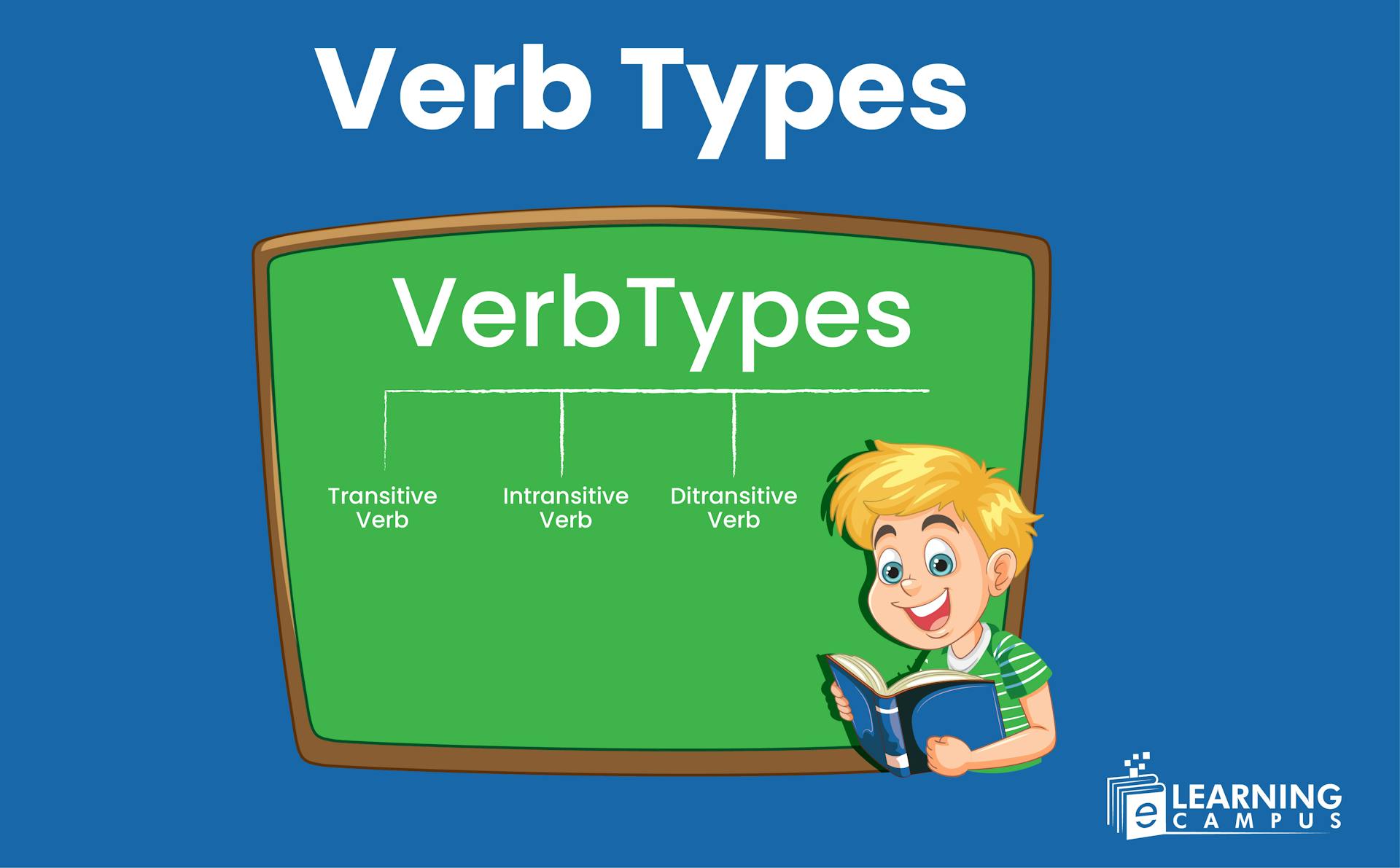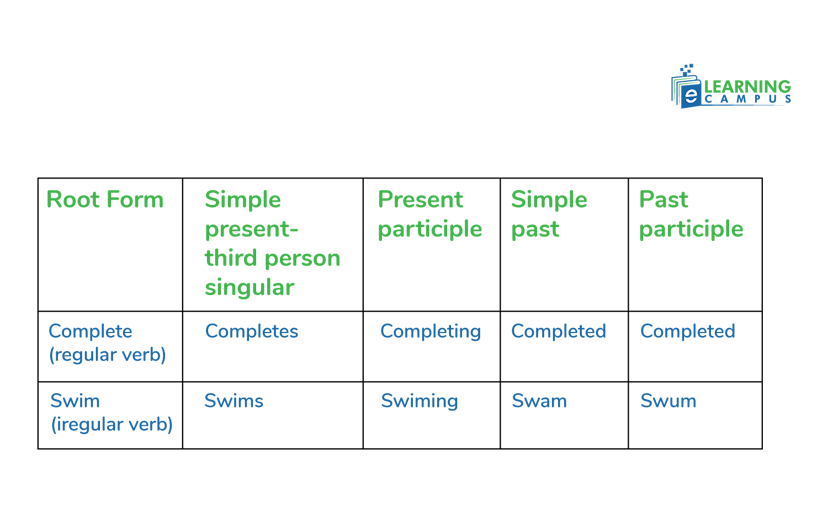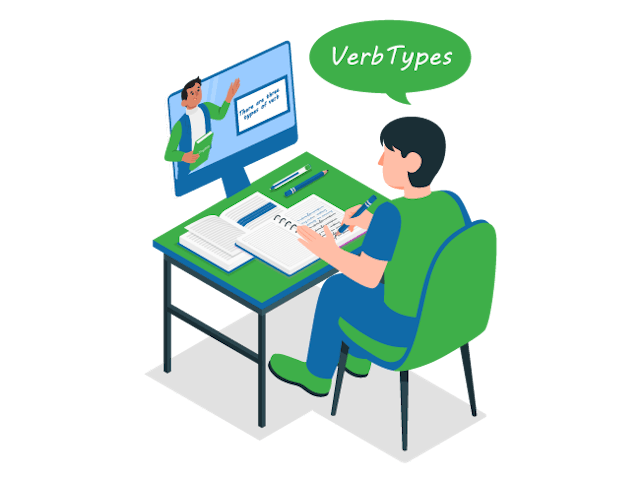Verb Types

Actions are an inevitable part of human life. The action can be physical, mental, or emotional. The word that describes an action is called a verb. Every sentence must contain at least one verb to be complete. There are several verb types in English grammar. Verbs are divided based on types, categories, and forms.
What is a Verb
A verb is a word that shows an action (run), an occurrence (happen), or a state of being (exist). As a part of speech in grammar, a verb conveys the action in the sentence. In addition to nouns, verbs are a critical component for sentence completion.
Types of verbs
A verb signifies action. There are several types of verbs categorized based on the kind of action they signify. Let’s look deep into the 3 types of verbs with examples.
Action Verbs
The action verbs show a specific action or state of being. These verbs show the actions that are performed physically, such as write, run, speak, etc., or the actions in which mental state or the brain is involved, such as think, consider, believe, etc.
Action Verb Examples List
- Eat
- Play
- Run
- think
- Fight
- Sleep
- Swim
- Believe
Examples of a sentence with a verb showing action
Stuart writes a letter.
Mary plays basketball.
Philips thinks to move to a new city.
Linking Verbs or Copular Verbs
The linking verbs, also known as Copular verbs, are those verbs that connect the subject in the sentence to the other parts of the sentence, such as the object, adjective, or prepositional phrase. All the ‘to be’ forms of the verbs are linking verbs. Other than verbs ‘to be’, become and seem also act as linking verbs.
The words act as verbs and linking verbs are as follows.
- Is
- Are
- Am
- be
- Become
- Smell
- taste
- Seem
- Grow
- appear
Examples of linking verbs in the sentence.
He is thirteen years old.
Lilly seems sad today.
The sofa feels comfortable.
The rose smells pleasant.
Auxiliary Verbs or Helping Verbs
Auxiliary verbs, also known as helping verbs, are the verbs that combine with the main verb to express the mood or voice of the main verb. The auxiliary or helping verbs usually come before the main verb in a sentence. At the time of writing, auxiliary verbs should be conjugated for tense and person.
The auxiliary verbs list is given below.
- Is
- Are
- Am
- Was
- Were
- Have
- Has
- Do
- Will
Use of Auxiliary verb examples in sentences.
Shelly is talking to Eric.
He has already eaten lunch.
Did you go to college yesterday?
Laura and Shella have been living in the USA. for a year.
In the above sentences, is, has, did, have are helping verbs and they express the mood and voice of the main verb. The main verbs are talking, eaten, go, and living.
Modal Verbs
Model verbs are the type of auxiliary verb. These verbs are used along with the main verb to express ability, possibility, permission, obligation, or necessity.
The main difference between auxiliaries and modals is that auxiliary verb change their form based on the subject, while modal verbs do not change their form.
The examples of modal verbs are:
- Can
- Could
- May
- Might
- Must
- Ought
- Shall
- Should
- Will
- would
Example of modal verbs in sentences.
Stuart can swim.
We must stay here tonight.
They should sort out this problem.
May I go for a walk?
Categories of Verbs
Based on the behaviour of verbs in context, they are divided into different categories. Let’s look deep into different categories of verbs.
Transitive Verb, Intransitive Verb, and Ditransitive Verb
The 3 types of verbs, i.e, transitive, intransitive, and ditransitive verbs, describe the verb acts with the direct and indirect objects.
- Direct object refers to a person or thing to which an action happens.
- Indirect object refers to a person or object that receives or accepts the direct object.
For example, Seema threw the ball to Maddy.
In the above example, Seema is the subject and threw is a verb. The ball is the direct object. Maddy is an indirect object as she received the ball (the direct object) from the subject.
By keeping direct and indirect objects in mind, let’s understand the transitive, intransitive, and ditransitive verbs with examples.
Intransitive verbs
A transitive verb is a verb that doesn’t require a direct or indirect object to make complete sense. These verbs, by themselves, are complete actions.
Transitive verb list.
- Go
- Walk
- Eat
- Run
- Speak
- Talk
- Sit
- Sleep
- Work
Transitive Verb
Verbs that use a direct object, but not necessarily use an indirect object, are transitive verbs.
The transitive verbs list is given below.
- Clean
- Like
- Love
- Dislike
- Hate
- Learn
- Deserve
- Say
Ditransitive Verbs
The verbs that need both direct and indirect objects to complete their meaning are known as ditransitive verbs.
Regular vs. Irregular Verbs
Regular verbs
Regular verbs are those that form their simple past and past participle by adding "-ed" (or sometimes "-d") to the base form of the verb.
Example of regular verbs.
The simple past of ‘finish’ will be ‘finished’.
Let’s look at some examples of regular verbs in the sentence.
Lilly completed her task.
We had cooked Mexican food yesterday.
She has finished her homework.
Lina and Harry will have finished their course by next month.
Irregular verbs
Irregular verbs have unique past tense and past participle forms that don't follow the "-ed" pattern.. For example, the past tense and past participle of ‘read’ is also ‘read’.
The examples of irregular verbs in the sentence are:
I spoke to my father about my plans.
The police have caught the thief.
They had sung Happy Birthday.
Verb Forms
Verbs can be modified based on the context of actions performed at a specific time. When the verb is changed or modified according to the action performed at a specific time, it is called a verb form. There are 5 forms of the verb, including root form, simple present, present participle, simple past, and past participle.
Root Verb
The root form of the verb is the original form of the verb without change or modification.
The examples of root forms of verbs are as follows;
- Sit
- Sing
- Read
- Stir
- Type
- Eat
- Fry
- Tick
- Shift
- Trick
These are the original form of the verb without any modification.
Simple Present– Third Person Singular
In English grammar, the third-person singular present tense refers to verbs used when discussing one person or thing (the third person), and the subject is singular (he, she, it, or a singular noun). In the simple present tense, third-person singular verbs typically end in -s or es.
For example,
He plays the piano.
She walks to school.
It shines brightly.
My dog barks loudly.
When the verb ends with ‘y’, then it is replaced by ies. For ‘study’ will be changed to studies.
Present Participle
The present participle is used in the continuous tense, which shows the continuity or progress of any action. Usually, ‘ing’ is added at the end of root verbs.
Examples.
Hera is playing football with her sister.
My mom was baking cake in the evening.
They will be going on to trip next week.
Simple Past
In the simple past tense of the verb, the spelling of the root verb is changed. The spell of the root verb depends on the verb used. It varies for different verbs. However, the regular verbs can be made past tense by adding ‘d’ or ‘ed’ at the end of the root verb.
Example of the simple past form of the verb in the sentence.
The teacher asked me to bring a glass of water.
Huma bought a new car.
She drank the juice completely.
Past Participle
The participle form of the verb shows the perfect tense form. For the regular verbs, the past participle is the same as the simple past. But in the case of an irregular verb, the spelling of the verb changes according to the context.
Examples.
I have completed my task.
She had read the book.
They had bought the laptop.
Form of the Verb Chart English
It is tricky to use the different forms of the verb according to the context. The form of the verb chart English will help you to understand the concept easily.

Conclusion
Verbs play an important role in English grammar. A sentence without verb can not give a complete sense and meaning. Several verb types play a crucial role in understanding the English language. If you want to master the English language, you should learn about verbs with examples.
Master the English Language with Us
Are you struggling with English reading, writing, and speaking? Don’t worry, we can help you. We have professional online English tutors to make you fluent in English language.
